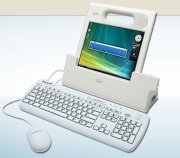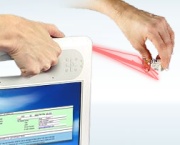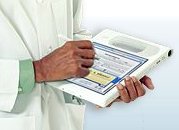Motion C5: Mobile Technology Helping Real People
Austin (TX) - A company called Motion, working in tandem with Intel through Intel Health, has developed a truly usable piece of technology. It's an amped up tablet PC with abilities specifically built in for the health care fields. And while that may sound boring in and of itself, and while it's one thing to have hardware, the Motion C5 brings together some powerful software features and slick interfaces, which is where its real power lies.
The Motion C5 also takes the doctor's chart to a whole new level. Nurses can physically carry them around as need. Doctors can too. Doctors can walk into a room carrying the same device that was used seconds before to view the other patient's chart. Anything flagged by the nurse or other doctors will come up, and any real-time relayed vital stats will be available, including a history for immediate review. Anyone logged into the system can access the common database and, no matter where they area of the medical facility they're in, see live charts with everything for every patient, as is piped through the network.
Motion was founded in 2001, headquartered in Austin, Texas. They sell products to 24 countries in North America, Europe, Australia and Asia. Their products are in a continual state of improvement as this field of technology is particularly lucrative. It is likely that several significant advancements in database management, those which are contextually aware, while simultaneously being appropriately so, will be made at Motion. Their close partnership with Intel will undoubtedly also foster an exchange of knowledge and technology from future many-core, compute intensive applications, specifically those targeted for Larrabee and Terascale.
Author's opinion
Software is getting ready to make a huge leap. Presently, nearly everything is event driven. In fact, it's the basis of the computer architecture. Still, the events driving the actual applications, for the most part at least, are directed by humans. We specify something, such as clicking on a document to open it. The machine responds to that event and does it.
In the future, the machines will use event models to determine what it is most likely that thing we'd want to do at a given time. The machine will then take a cue from that model and do in advance that thing of our modeled request. If we end up not using it, then nothing was really wasted as it can simply be closed, or moved into the background. If we do end up using it, however, then there it is already ready already.
Software ideas like these are win-win for users, and the Intel Health software this machine uses is part of that global software design paradigm. There's almost nothing to be lost by having contextual aware user interfaces, and so much can potentially be gained. There will likely be a period of several years of annoying, and oh so annoying, quirks as this type of user interface is flushed out. Still, in the end, and certainly by the year 2020, the computers we use then will bear so little resemblance to the computers we use today, and not just in performance increases, but rather the entire experience.
I have seen hints of this cropping up in various software efforts for years. To my knowledge, outside of strict academia, no one has made a truly beneficial commercial product which yet brings together all of these machine abilities we possess today in a usable way. The Motion C5, when I read about it, was about the closest device I've seen toward that end. I'm sure it still has a long way to go to be completely usable, but it was enough to cause me to write this article.
Get Tom's Hardware's best news and in-depth reviews, straight to your inbox.
I would very much like to challenge software developers, of which I am one, to begin focusing their attention on this type of software development. The experts at Intel that I have personally interviewed on high-performance, future computing, all indicate one thing very clearly: It is the software model of tomorrow.



